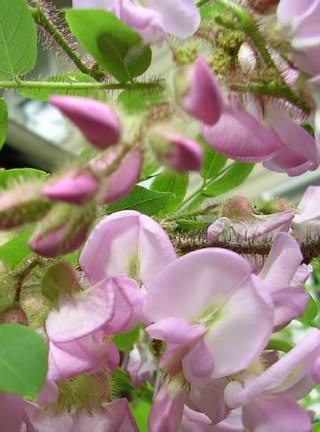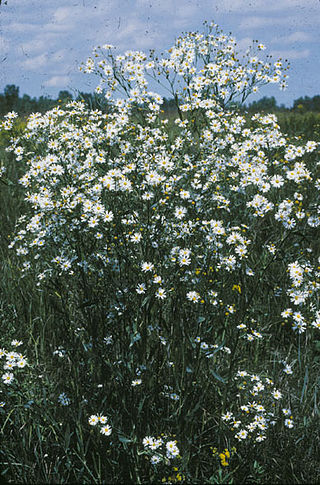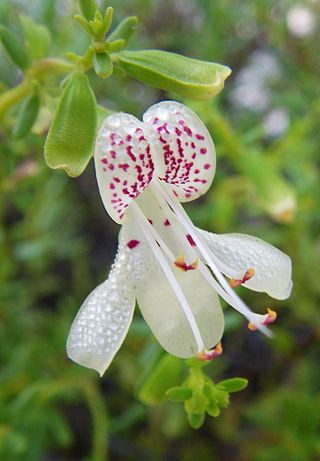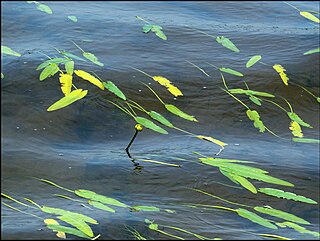
Aristida stricta is a warm-season grass, native to North America, that dominates understory vegetation in sandhills and flatwoods coastal plain ecosystems of the Carolinas in the Southeastern United States. It is known as wiregrass and pineland three-awn grass.

Robinia hispida, known as the bristly locust, rose-acacia, or moss locust, is a shrub in the subfamily Faboideae of the pea family Fabaceae. It is native to the southeastern United States, and it is present in other areas, including other regions of North America, as an introduced species. It is grown as an ornamental and can escape cultivation and grow in the wild.

Boltonia asteroides, the white doll's daisy, false chamomile, or false aster, is a species of plant native to the United States and Canada. It is found primarily in the Mississippi Valley and Great Plains from Saskatchewan south to Texas and Florida, with isolated populations in the eastern United States. Reports of the species in New England, New York, and the Pacific Northwest appear to be introductions.

Chrysopsis are plants in the family Asteraceae native to the southern and eastern United States. All the species are found in Florida, although some are found in other states as well.

Blephilia, the pagoda plant or wood mint, is a genus of four species of flowering plants in the family Lamiaceae. They are all herbaceous plants native to eastern North America. Blephilia are most often found in open areas, glades, and mesic forests. All species of Blephilia are considered threatened or endangered in some states.
Eupatorium leucolepis, commonly called justiceweed or white-bracted thoroughwort, is a herbaceous perennial plant in the family Asteraceae native from the eastern coastal United States, from New York to eastern Texas, with scattered populations inland as far as Kentucky and West Virginia.

Solidago rugosa, commonly called the wrinkleleaf goldenrod or rough-stemmed goldenrod, is a species of flowering plant in the family Asteraceae. It is native to North America, where it is widespread across eastern and central Canada and the eastern and central United States. It is usually found in wet to mesic habitats.

Dicerandra frutescens is a rare species of flowering plant in the mint family known by the common names scrub mint and scrub balm. It is endemic to Highlands County, Florida, where it is known only from the Lake Wales Ridge. Its habitat is quickly being lost as it is converted to residential and agricultural use. It was federally listed as an endangered species of the United States in 1985.

Dicerandra immaculata is a rare species of flowering plant in the mint family known by the common names Lakela's mint, Olga's mint, and spotless balm. It is endemic to Florida in the United States, where it is known only from Indian River and St. Lucie Counties. There are seven occurrences of the plant, two of which are scheduled for destruction as the land is cleared for development. The plant was federally listed as an endangered species in 1985.

Dicerandra is a genus of flowering plants in the mint family. Dicerandra comprises 11 species: six perennial and five annual species. The perennials have narrow ranges in Central Florida with small population sizes and only occur on ancient dune ridges along the Lake Wales Ridge or the Atlantic coastal ridge; the annual species occur more broadly on sandhill habitats to the north. The perennials’ habitat has been severely fragmented due to human development over the past century. As a result, all perennial species except one are listed as federally endangered. Annual species of the clade have large ranges when compared to perennial members, with distributions of annuals ranging for hundreds of miles from the Panhandle of Florida to southeastern Georgia, with the exception of Dicerandra radfordiana which is endemic to two sites along the Altamaha river. The genus is characterized by hornlike spurs on their anthers.

Panax trifolius, commonly called dwarf ginseng, is a plant native to the Northeastern and Appalachian regions of North America. It is found in low mesic woods with acidic soils.
Eupatorium novae-angliae, commonly called New England boneset, New England justiceweed or New England thoroughwort, is a rare and endangered North American species in the family Asteraceae. It is found only in 4 counties in southern New England. The species is listed as endangered species in both states.
Eupatorium paludicola, also called swamp justiceweed, is a rare North American species of plant in the family Asteraceae, found only in the States of North Carolina and South Carolina in the southeastern United States.

Hymenopappus scabiosaeus, the Carolina woollywhite, is a North American species of flowering plant in the daisy family. It grows in the central and southeastern United States, primarily on the Great Plains an on the Coastal Plain of the Southeast. There are also isolated populations in Illinois and Indiana as well as in the state of Coahuila in northern Mexico.

Nuphar sagittifolia, common name arrow-leaved water-lily or Cape Fear spatterdock, is a plant species known only from North Carolina, South Carolina, and Virginia.
Dicerandra densiflora, the Florida balm, is a species of flowering plant in the mint family known by the common names scrub mint and scrub balm. It is native to North Central Florida, where it occurs along sand hill habitats. It is a member of the annual subclade of Dicerandra. D. densiflora grows up to 2 ft (61 cm) tall. Flower petals are lavender to purple in color with dark spots.
Dicerandra fumella is a species of Dicerandra native to the Florida Panhandle. It was formerly classified as a variety of Dicerandra linearifolia. A hybrid zone between Dicerandra fumella and Dicerandra linearifolia var. robustior is located in the Marianna Lowland, west of the Apalachicola River in Florida.
Dicerandra odoratissima, commonly known as the rose balm, is a species of Dicerandra native to the Southeastern Coastal Plain, with a geographic range that extends from eastern Georgia to southern South Carolina. Kral (1982) originally suggested that this species was so distinct from the remaining members of the genus that it should be placed in a separate section or a distinct genus. Today, D. odoratissima and its close relative D. radfordiana are members of the Lecontea clade.

Dicerandra radfordiana, or Radford's balm, is an annual species of Dicerandra native to Eastern Georgia. It is found along the Altamaha River bluffs where deep, well drained sands are common. Only two populations are currently known, with one on public land and another, on private land, where it is protected by a conservation easement. The size of each population varies from year to year depending on the amount of rainfall.

Pelazoneuron ovatum, synonym Thelypteris ovata, the ovate marsh fern or ovate maiden fern, is a species of fern in the Thelypteridaceae family. Native to the southeastern United States, this fern can be found in riverbanks and moist canyons. In Georgia it can be found in the Coastal Plain.













